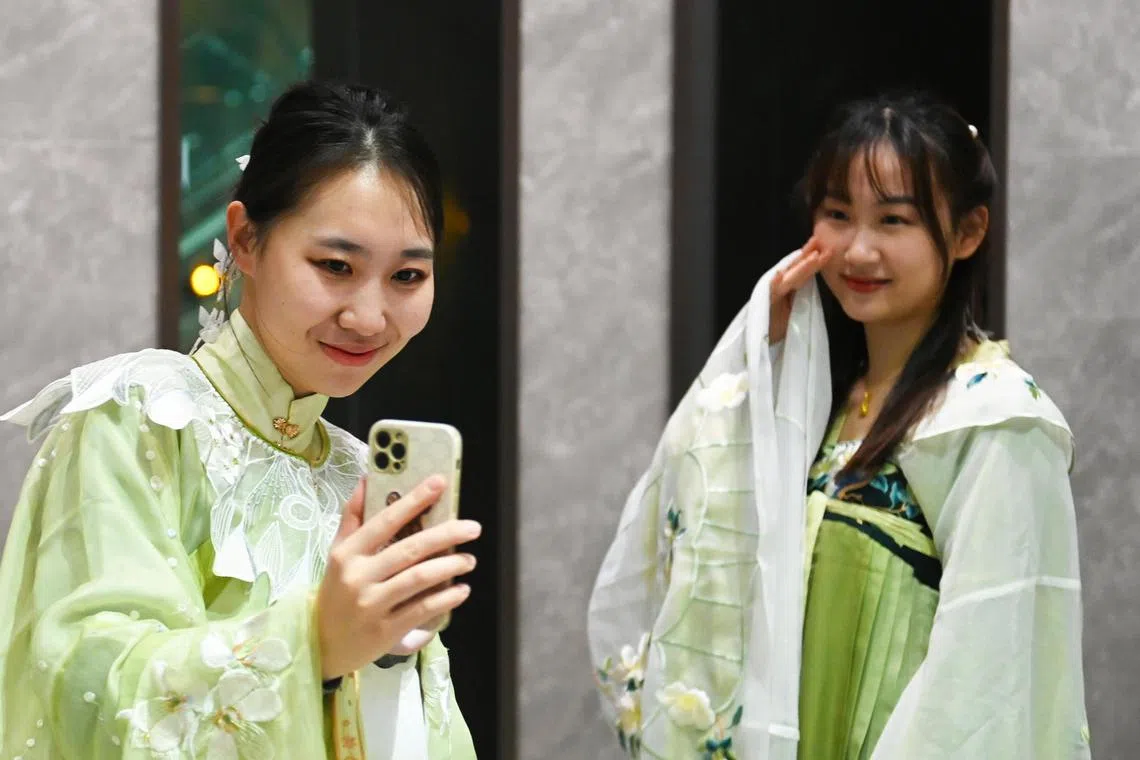Traditional costumes see growing popularity among young people in China
Sign up now: Get insights on Asia's fast-moving developments

The hanfu market in China is expected to rise to 19.11 billion yuan (S$2.44 billion) by 2025.
PHOTO: XINHUA
Follow topic:
BEIJING – Dressed in long robes, a crowd of young people wander around pavilions and royal gardens, their flowing sleeves and heavily embroidered skirts gently swaying in the breeze.
They are not actors on a movie set, but hanfu enthusiasts at a themed event in Beijing.
“Over a decade ago, hanfu fashion was an obscure subculture, but (such) activities nowadays often draw thousands of participants,” said Ms Liu Xiang, an organiser of the event.
Benefiting from the growing popularity of social media and a craze for traditional culture, hanfu, a traditional style of clothing once worn by the Han people, has enjoyed a fresh lease of life, thanks to a new wave of young Chinese devotees, including Ms Liu.
Ms Liu, a 1980s-born rocket scientist, is also a co-founder of a hanfu community in Beijing called Hua Yan Hui.
The community was founded in 2011 following a hanfu revival movement that emerged from the desire to express national identity and growing cultural confidence. Since then, Ms Liu has been volunteering to support the group.
“My passion for hanfu came from two of my friends who are fans of traditional Chinese clothing,” Ms Liu said. Her interest grew as she learnt more about the culture behind it and acquired her first hanfu costume.
At first, people who wore hanfu in public were occasionally greeted with derision, while some passers-by asked about their clothing style, said Ms Liu.
More young people are taking to wearing adapted hanfu as they believe the best way to preserve tradition is to adapt it to modern life.
Ms Yang Kunning was born in the 1990s and works in public relations. She is fond of sharing her love for hanfu online. She opened an account on video-sharing platform Bilibili and posted videos featuring herself wearing the traditional attire.
Thousands of comments and likes pour in to her channel as viewers find her videos attractive and creative – blending traditional culture with modern dance movements.
“Social media has made hanfu culture popular in China and abroad,” said Ms Liu. “Traditional culture has no national or ethnic boundaries.”
Savvy companies and factories also see the massive potential in hanfu-related industries.
Caoxian county in Heze city, in east China’s Shandong province, is one of the major hanfu manufacturing centres, gathering more than 2,000 upstream and downstream enterprises and creating jobs for nearly 100,000 people. More than 600 clothes-processing companies have their own designs with intellectual property rights.
In addition to domestic clients, a number of companies in Caoxian reported a surge in foreign orders in 2023.
Ms Yang has a collection of around 30 hanfu outfits, suitable for different seasons and occasions. She said customers now have many choices when selecting hanfu, ranging from economical to high-end collections.
The hanfu market in China was estimated to have reached 12.54 billion yuan (S$2.4 billion) in 2022 and is expected to rise to 19.11 billion yuan by 2025, according to research firm iMedia Research.
Ms Yang’s cousin Lu Siqing, who works for a consulting agency, said: “My work requires me to keep up with the newest changes in the market, and my experiences with hanfu culture and related businesses help me better understand the mindset of the consumers.”
With China relaxing its Covid-19 prevention and control measures, the recovery of the cultural and tourism industry has seen a quick rebound. Ms Yang said she looks forward to participating in more in-person hanfu-themed events this year in Beijing.
“It will be a rewarding experience to participate in events in the Forbidden City and other historical palaces in the capital city,” she said. CHINA DAILY/ASIA NEWS NETWORK

